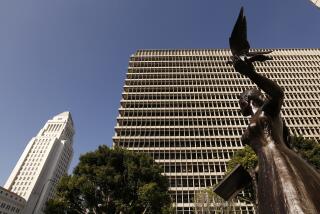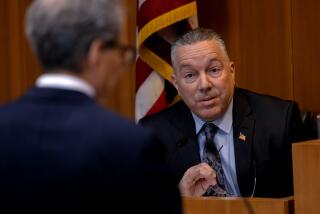U.S. Must Prove Intent in Case Against Company
- Share via
On Oct. 23, senior executives in Andersen’s Houston offices that handled the firm’s audit of a faltering client, Enron Corp., attended a meeting, one of a series they would hold that day. The topics of discussion, according to a typed agenda, included “SEC probe/shareholder lawsuits” and “soft and hard copy file review.”
The day before, Enron had disclosed a Securities and Exchange Commission inquiry involving its off-the-books partnerships. The Oct. 23 meetings in Houston were followed by three days of document shredding, in which Andersen staffers destroyed at least 26 trunks and 24 additional boxes filled with records related to Enron--leading to a Justice Department indictment of Andersen on an obstruction of justice charge.
Now, the fate of the 89-year-old accounting giant turns largely on what Andersen executives were thinking Oct. 23, as a conviction could force the company out of business. The intent of these executives, particularly former partner David Duncan, is expected to become the fulcrum of the legal battle unfolding between Andersen and federal prosecutors.
Andersen disclosed in January that company employees “disposed of a significant but undetermined number of electronic and paper documents and correspondence” related to Enron. Four days later it announced the firing of Duncan and the suspension of three other partners in Houston in connection with the shredding.
But destroying the Enron-related papers isn’t necessarily a crime. Instead, the key to proving a violation of the obstruction law, legal experts said, is showing that a defendant “corruptly persuaded” others to act.
Even if the senior executives told employees that the shredding was needed to comply with legitimate company policy, Andersen could be convicted if prosecutors show the executives’ real intention was to keep records away from an official investigation, experts said. But there are varying legal definitions of “corrupt,” potentially giving a jury great leeway in determining the outcome.
The loose legal standards mean prosecutors could vastly improve their case by finding an Andersen executive who is willing to testify about their intentions, perhaps under an immunity agreement. Duncan, the lead partner on the Enron account, met with prosecutors last week, but it is unclear if such a deal will emerge. Prosecutors also may seek deals with other executives familiar with Andersen’s October meetings.
Under law, the firm may be held liable for the actions of its employees.
Since the Justice Department unsealed its indictment March 14, Andersen has toned down its condemnation of Duncan. In announcing Duncan’s dismissal in January, Andersen said “it should be perfectly clear that Andersen will not tolerate unethical behavior, gross errors in judgment or willful violation of our policies.”
But lately, Andersen lawyers have been saying that Duncan merely made a mistake amid confusion over what the firm now describes as its flawed document-retention policy, and that he didn’t break any laws.
“I think Duncan did what he thought was right,” said Rusty Hardin, a lawyer for Andersen.
Instead, Andersen is expected to argue that in a rush to comply with the firm’s policy--which essentially called for destroying any drafts, notes, e-mail or other documents not needed to back up an auditor’s conclusions--Andersen executives violated it.
In an internal report, Andersen criticized the policy for its “lack of clarity,” according to excerpts the company released.
But even if the Justice Department obtains witness testimony from Andersen officials, the accounting firm may be able to draw out evidence to show there were many competing motives behind the shredding.
“By the time you get to trial, 98% of the who, what and where is known to both sides and the whole fight is over the why,” said Peter Romatowski, a defense lawyer in Washington and a former federal prosecutor. “There’s going to be room to argue both sides of that, even if there are witnesses who tell it the government’s way.”
If prosecutors are unable to persuade any Andersen executives to testify, they probably will try to prove their case by using other evidence in a bid to shed light on their intent. A huge quantity of internal documents and correspondence about the shredding effort has been turned over to federal officials.
Andersen’s report said that by the time of the Oct. 23 meetings, Duncan and other partners handling the Enron account knew that the Securities and Exchange Commission had made an informal request to Enron for information related to partnerships headed by its former chief financial officer, Andrew S. Fastow.
Duncan and another partner, Debra Cash, had met with Enron executives the day before and learned that Enron was expecting a second SEC letter asking for accounting-related information and that Enron had hired a new law firm to examine the Fastow partnerships, according to the Andersen report.
The report also said one person’s notes from an Oct. 23 meeting include the directive “clean up--documentation” followed by “SEC voluntary request/two suits filed, more on way.” But the report said staffers who cleaned up their files after the Oct. 23 meetings “apparently did so openly, with no sense that they were doing anything wrong or illegal.”
In a Nov. 9 e-mail, Duncan’s assistant told others to stop shredding because the firm had received an SEC subpoena.
But Hardin said, “If you’ve got a conspiracy to destroy documents, why do you send an in-the-open e-mail Nov. 9, saying ‘Stop it’?”
Prosecutors also are expected to prove intent by contending that the document destruction far exceeded typical levels. Andersen acknowledged in its report that “the timing and scale of the destruction activity that occurred do not appear to have been normal,” but said the records were “non-work papers” that routinely would have been purged.
Andersen’s internal report said communications between the Houston office and Andersen officials in Oregon and London resulted in additional document destruction in those offices, but that the shredding in Chicago “does not appear to have been coordinated” with Houston.
But prosecutors are expected to emphasize the scale of document destruction.
“The prosecution effort will always be to show something greater than the bare minimum,” Romatowski said. “The defense will be attempting to minimize the scope of the activity horizontally and vertically. The question for the jury will be to find the degree of the activity. You can’t X-ray people’s heads to find out their intent.”
More to Read
Inside the business of entertainment
The Wide Shot brings you news, analysis and insights on everything from streaming wars to production — and what it all means for the future.
You may occasionally receive promotional content from the Los Angeles Times.










